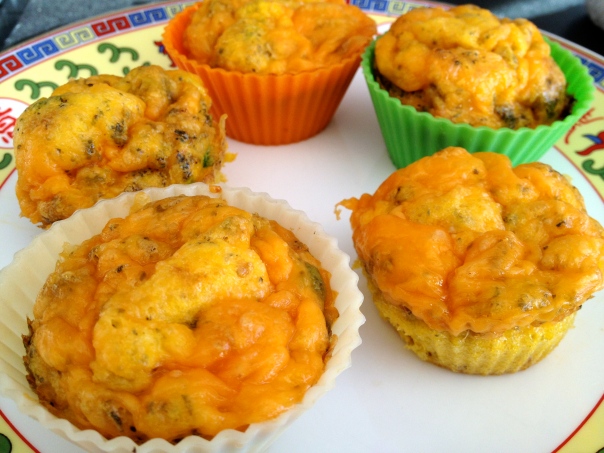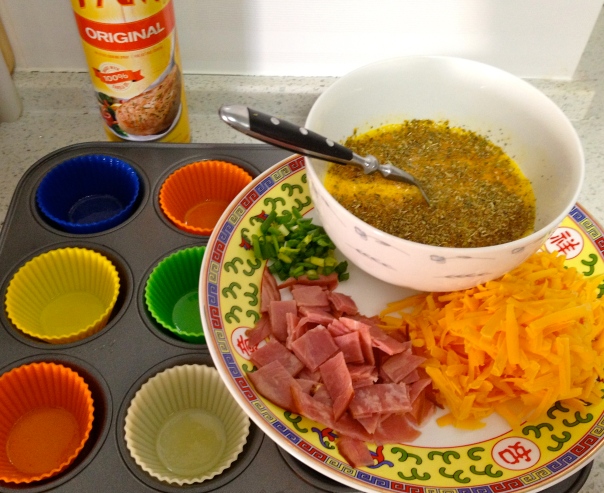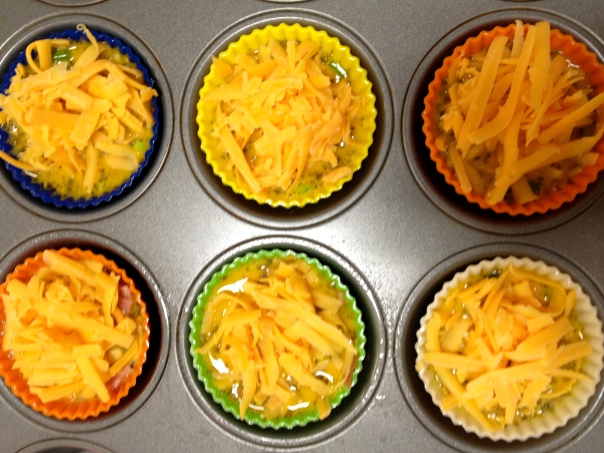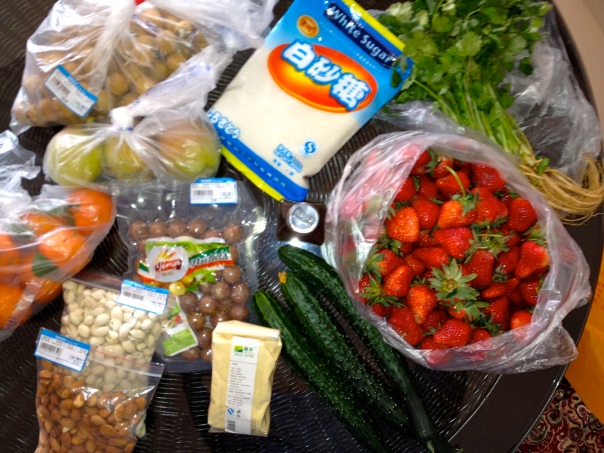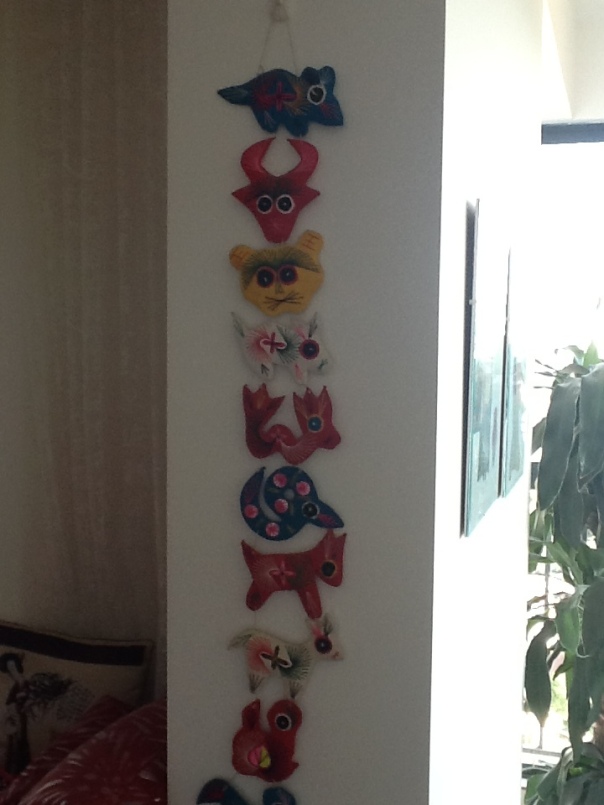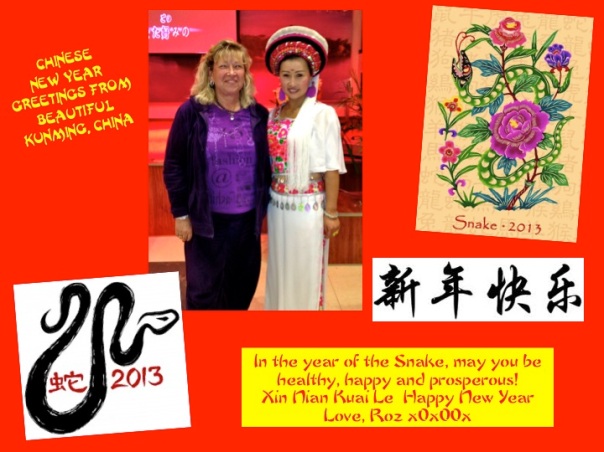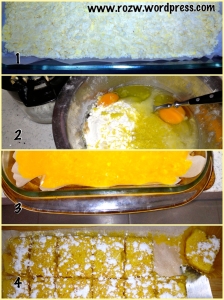Monthly Archives: February 2013
Breakfast Egg Muffins
Makes 6 breakfast muffins
½ cup diced Canadian bacon or smoked ham
2 green onions diced finely
4 eggs, beaten (for individual silicone muffin cups, and use 3 eggs for metal muffin tins with two paper liners in each)
1 teaspoon or your favourite spice blend (I used Italian spice)
1 cup grated cheddar cheese or any other kind you like
Get your baking containers ready. Spray with silicone cups with nonstick spray. If you are using regular muffin pan, then spray the paper liners with nonstick spray.
Place diced meat and green onions in the bottoms of the cups.
Add spice mix to the beaten eggs. Pour egg into each muffin cup until they are 3/4 full. Add the cheese on top.
Bake for 20-25 minutes at 375 F until muffins rise, are slightly browned and the eggs are set. Run the knife around the muffins if using silicone cups for easy removal.
Enjoy!
You can store muffins in the refrigerator for a week or freeze but thaw before reheating.
Grocery Shopping in China
Today’s the fourth day of Chinese New Year and almost every shop along my street has been closed since before the holiday. Luckily I had stocked up. But today I went out looking for cilantro to make some winter melon soup for dinner and fruit and nuts for snacks for some friends who may come and visit me in the next few days. So here’s what I got for the equivalent of $26.00: 3 cucumbers and cilantro, a small bottle of sesame oil, 1/2 pound corn flour and 2 pounds sugar. Fruit: 1-1/2 pounds lichee fruit, 6 mandarin oranges, 4 pounds strawberries (to freeze for breakfast smoothies), 3 pears, and nuts – 1/2 pound almonds, 3/4 pound pistachios and 1/2 pound macadamias. Actually the price of everything is inflated by about 15% because it’s a holiday.
Cost in Toronto?
10 Steps Closer to Understanding Chinese New Year
Many symbols and customs surround Chinese Lunar New Year celebrations. And living in China since 2005 has given me some insight into each symbol or custom which has its own deep meaning and importance. By learning about these customs and traditions, you too can bring prosperity and happiness into your lives.
Chinese Lunar Calendar:
The Western calendar follows the sun cycles whereas the Chinese Lunar Calendar is based on the cycles of the moon. This Chinese New Year symbol often shows the dates of both the Western calendar and the Chinese Lunar Calendar. The Western dates are printed in Arabic numerals, and the Chinese dates are communicated in Chinese numerals.
Chinese Zodiac:
The 12 animals of the Chinese Zodiac have a specific order according to a folk tale and the animal signs are repeated every twelve years. 2013 is the year of the Snake and 2014 will be the year of the Horse. The fifth time that an animal is repeated in a person’s life is their Golden year. So when a person reaches their 60th year, their sign is golden.
Flowers:
Flowers are very prevalent in all Chinese New Year decorations. The plum blossom and the water narcissus are the two flowers most associated with the New Year.
Plum Blossoms: The plum blossom stands for courage and hope because the blossoms appear at the end of winter when it’s still quite cold on plants that look for the most part dead. When shown in art in general, plum blossoms are associated with the entire season of winter.
Water Narcissus: The water narcissus signifies good luck and fortune. It’s a flower that blossoms usually at New Year’s time. If the white flowers blossom on the New Year Day, this means that one would have good fortune for the next twelve months.
Hong Bao or Red Envelopes:
Children and young adults receive hong bao at Chinese New Year’s time. The envelopes contain money or gold covered chocolate coins. The money must be in new bills, and the total amount must be an even number. Certain numbers (such as four) are bad luck, so the total amount should not be one of these unlucky numbers. “Four” is a homonym for “death”, so a red envelope should never contain $4, $40, or $400. While mainly given to children, some employees of high company standing will receive a large hong bao bonus and regular employees will receive an extra month’s salary in the red envelope.
Fireworks:
Since it is common to believe that evil spirits are driven away by loud noise, the setting of loud firecrackers is prevalent throughout the 14-day holiday celebration. Long strings of firecrackers are set off as fireworks light up the evening and morning skies . Taiwan and Mainland China still allow almost unrestricted use of firecrackers and other fireworks.
Lucky Character:
The single word “FU”, or fortune, is often displayed in many homes and stores, supposed to be a lucky Chinese New Year symbol. They are usually written by brush on a diamond-shaped piece of red paper. When placed upside down, the meaning changes to ‘Bringing in the good fortune’.
Spring Couplets:
Spring couplets are a very old symbol and holding traditional significance, usually written with black ink on red paper. They are hung in storefronts and on household doorways in the month before the Chinese New Year’s Day, and often stay up for many months afterwards. They all express best wishes and fortune for the coming year.
Tangerines and Oranges:
Tangerines for good luck and oranges for wealth are frequently displayed in homes and stores.
Chinese like playing with words and symbols. Often homonyms (words that share the same pronunciation but have different meanings) are used. The word tangerine has the same sound as “luck” in Chinese, and the word for orange has the same sound as “wealth”.
Tray of Togetherness:
Most families keep a tray full of dried fruits, sweets, and candies to welcome guests and relatives who come for visits. This tray is a “tray of togetherness”. This Chinese New Year symbol was traditionally made up of eight compartments, each with a specific significance.
The Chinese cling to the cultural traditions of this holiday to make this one of their most special yearly celebrations.
Happy Chinese New Year 2013 in the Year of the Snake
Today is Saturday, February 9th in China. Tonight is the beginning of the Chinese Lunar New Year, the eve of the year of the snake. Celebrations have already begun. Fireworks are being heard all around China. The mood is high; the fun is beginning. Tonight millions of people all over the world will watch the Chinese New Year’s Gala on TV…a 4.5 hour spectacle of entertainment from China.
I send you my New Year’s greetings, all the way from Kunming, Yunnan Province, China. The photo was taken with a beautiful Dai lady in her traditional ethnic costume at a CNY celebration dinner last week at Guandu Ancient Town, where I was invited to attend along with over 1,000 other guests – the only foreigner in the hall! What an honour!
Luscious Lemon Squares
- Prepare the crust by mixing together the softened butter, flour and sugar with a pastry cutter, hand mixer or a fork. Press the mixture onto the bottom of a parchment paper lined baking pan. Bake in a preheated oven at 350 degrees F (175 degrees C) for 20 minutes, or until golden brown.
- Beat together the ingredients for the filling.
- Pour over the baked crust.
- Bake for 20 minutes. The lemon filling may not be solid but will firm up as it cools. Carefully remove from the pan onto a cutting board together with the paper while still hot. Sprinkle with powdered icing sugar. Cut into squares when cool with a sharp knife dipped in cool water each time you make a slice and place in muffin papers.
- Enjoy!
7 Yunnan Recipes on GoKunming – Check them out!
If you try any of these recipes, I would love to have your feedback in my Comment’s Box:
- Recipe: Yunnan-style red beans and shiitakes January 29, 2013
- Yunnan-style tomato salad December 24, 2012
- Recipe: Shredded chicken with chili sauce November 29, 2012
- Recipe: Spicy taro and greens November 11, 2012
- Recipe: Yunnan-style pork and egg custard October 2, 2012
- Recipe: Yunnan-style lotus root and pork September 16, 2012
- Recipe: Yunnan-style edamame beans and garlic September 1, 2012
NEWLY PUBLISHED: Have a look at my ecookbook, “Roz Weitzman’s World of Chinese Comfort Food” on Amazon.com and Lulu.com
